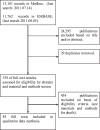Circulating biomarkers for predicting cardiovascular disease risk; a systematic review and comprehensive overview of meta-analyses
- PMID: 23630624
- PMCID: PMC3632595
- DOI: 10.1371/journal.pone.0062080
Circulating biomarkers for predicting cardiovascular disease risk; a systematic review and comprehensive overview of meta-analyses
Abstract
Background: Cardiovascular disease is one of the major causes of death worldwide. Assessing the risk for cardiovascular disease is an important aspect in clinical decision making and setting a therapeutic strategy, and the use of serological biomarkers may improve this. Despite an overwhelming number of studies and meta-analyses on biomarkers and cardiovascular disease, there are no comprehensive studies comparing the relevance of each biomarker. We performed a systematic review of meta-analyses on levels of serological biomarkers for atherothrombosis to compare the relevance of the most commonly studied biomarkers.
Methods and findings: Medline and Embase were screened on search terms that were related to "arterial ischemic events" and "meta-analyses". The meta-analyses were sorted by patient groups without pre-existing cardiovascular disease, with cardiovascular disease and heterogeneous groups concerning general populations, groups with and without cardiovascular disease, or miscellaneous. These were subsequently sorted by end-point for cardiovascular disease or stroke and summarized in tables. We have identified 85 relevant full text articles, with 214 meta-analyses. Markers for primary cardiovascular events include, from high to low result: C-reactive protein, fibrinogen, cholesterol, apolipoprotein B, the apolipoprotein A/apolipoprotein B ratio, high density lipoprotein, and vitamin D. Markers for secondary cardiovascular events include, from high to low result: cardiac troponins I and T, C-reactive protein, serum creatinine, and cystatin C. For primary stroke, fibrinogen and serum uric acid are strong risk markers. Limitations reside in that there is no acknowledged search strategy for prognostic studies or meta-analyses.
Conclusions: For primary cardiovascular events, markers with strong predictive potential are mainly associated with lipids. For secondary cardiovascular events, markers are more associated with ischemia. Fibrinogen is a strong predictor for primary stroke.
Conflict of interest statement
Figures




Similar articles
-
Drugs for preventing postoperative nausea and vomiting in adults after general anaesthesia: a network meta-analysis.Cochrane Database Syst Rev. 2020 Oct 19;10(10):CD012859. doi: 10.1002/14651858.CD012859.pub2. Cochrane Database Syst Rev. 2020. PMID: 33075160 Free PMC article.
-
Mobile phone text messaging for medication adherence in secondary prevention of cardiovascular disease.Cochrane Database Syst Rev. 2024 Mar 27;3(3):CD011851. doi: 10.1002/14651858.CD011851.pub3. Cochrane Database Syst Rev. 2024. PMID: 38533994 Free PMC article.
-
Smoking cessation medicines and e-cigarettes: a systematic review, network meta-analysis and cost-effectiveness analysis.Health Technol Assess. 2021 Oct;25(59):1-224. doi: 10.3310/hta25590. Health Technol Assess. 2021. PMID: 34668482
-
Effects of a gluten-reduced or gluten-free diet for the primary prevention of cardiovascular disease.Cochrane Database Syst Rev. 2022 Feb 24;2(2):CD013556. doi: 10.1002/14651858.CD013556.pub2. Cochrane Database Syst Rev. 2022. PMID: 35199850 Free PMC article.
-
Electronic cigarettes for smoking cessation.Cochrane Database Syst Rev. 2021 Sep 14;9(9):CD010216. doi: 10.1002/14651858.CD010216.pub6. Cochrane Database Syst Rev. 2021. Update in: Cochrane Database Syst Rev. 2022 Nov 17;11:CD010216. doi: 10.1002/14651858.CD010216.pub7. PMID: 34519354 Free PMC article. Updated.
Cited by
-
Vitamin D status and hypercholesterolemia in Spanish general population.Dermatoendocrinol. 2013 Jun 1;5(3):358-62. doi: 10.4161/derm.27497. Epub 2013 Dec 18. Dermatoendocrinol. 2013. PMID: 24516690 Free PMC article.
-
Fitness age outperforms body mass index in differentiating aging patterns and health risk profiles of healthy adults aged 51-80 years.Geroscience. 2024 Dec;46(6):5875-5890. doi: 10.1007/s11357-024-01125-z. Epub 2024 Mar 18. Geroscience. 2024. PMID: 38499955 Free PMC article.
-
Association Between Markers of Inflammation and Total Stroke by Hypertensive Status Among Women.Am J Hypertens. 2016 Sep;29(9):1117-24. doi: 10.1093/ajh/hpw050. Epub 2016 May 28. Am J Hypertens. 2016. PMID: 27235695 Free PMC article. Clinical Trial.
-
2023 Guidelines of the Taiwan Society of Cardiology on the Diagnosis and Management of Chronic Coronary Syndrome.Acta Cardiol Sin. 2023 Jan;39(1):4-96. doi: 10.6515/ACS.202301_39(1).20221103A. Acta Cardiol Sin. 2023. PMID: 36685161 Free PMC article.
-
Variability in Sleep Duration and Biomarkers of Cardiovascular Disease Across the Menstrual Cycle.Am J Epidemiol. 2023 Jul 7;192(7):1093-1104. doi: 10.1093/aje/kwad060. Am J Epidemiol. 2023. PMID: 36928293 Free PMC article.
References
-
- Alwan A, Armstrong T, Bettcher D, Branca F, Chisholm D, et al. (2011) Burden: mortality, morbidity and risk factors. Global Status Report on Noncommunicable Diseases 2010: 9–32.
-
- Oxman AD, Cook DJ, Guyatt GH (1994) Users' guides to the medical literature. VI. How to use an overview. Evidence-Based Medicine Working Group. Jama 272: 1367–1371. - PubMed
-
- Moher D, Liberati A, Tetzlaff J, Altman DG (2009) Preferred reporting items for systematic reviews and meta-analyses: the PRISMA statement. Ann Intern Med 151: 264–269, W264. - PubMed
-
- Danesh J, Lewington S, Thompson SG, Lowe GD, Collins R, et al. (2005) Plasma fibrinogen level and the risk of major cardiovascular diseases and nonvascular mortality: an individual participant meta-analysis. Jama 294: 1799–1809. - PubMed
Publication types
MeSH terms
Substances
LinkOut - more resources
Full Text Sources
Other Literature Sources
Medical
Research Materials

